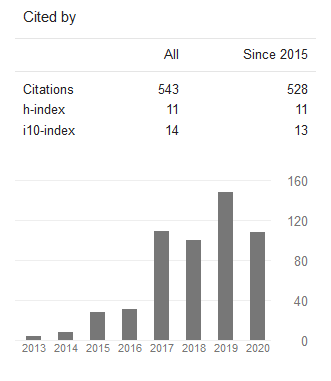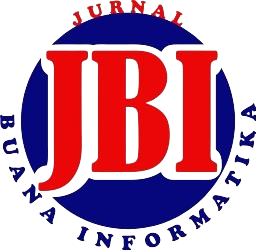Mengukur Tingkat Keselarasan Information Technology dan Bisnis (Studi Kasus Perusahaan Start-up Digital Wilayah Jawa)
DOI:
https://doi.org/10.24002/jbi.v9i2.1485Abstract
Abstract. The alignment between information technology (IT) and business becomes a main issue for a digital start-up which adopts technology as a support for the business activities. As one of the growing business in Indonesia, this organization gets special attention from the government that it will be able to become the backbone of the nation's economy. This has led to a necessity of measuring the alignment level between IT and business at digital start-ups in order to describe the conditions for developing strategies to increase competitive benefits. According to that necessity, the research on the assessment of the alignment between IT and business is conducted by using the Luftman SAM (Strategic Alignment Maturity) model to 30 samples of IT start-up companies from various business fields in Java where the center of digital start-up exists in Indonesia. Based on the results of this study, it was found that the average digital start-up has a pretty good alignment level of 3.45. This shows that the strategic alignment between IT and business is starting to integrate in all functional units.
Keywords: alignment maturity, Luftman, SAM, start-up.
Abstrak. Keselarasan teknologi informasi (IT) dan bisnis telah menjadi masalah utama start-up digital yang memanfaatkan teknologi sebagai penunjang dalam kegiatan bisnis. Sebagai salah satu organisasi yang marak berkembang di Indonesia, organisasi ini mendapatkan perhatian khusus dari pemerintah untuk mampu menjadi tulang punggung perekonomian bangsa. Hal ini menyebabkan perlunya pengukuran tingkat keselarasan IT dan bisnis pada start-up digital agar dapat menggambarkan kondisi keselarasan yang terjadi sehingga mampu menyusun strategi untuk semakin meningkatkan keuntungan kompetitif. Berdasarkan kebutuhan ini peneliti melakukan penilaian keselarasan antara IT dan bisnis dengan menggunakan model Luftman SAM (Strategic Alignment Maturity) terhadap 30 sampel perusahaan start-up IT dari berbagai bidang bisnis yang berada di wilayah Jawa dimana pusat pertumbuhan start-up digital di Indonesia berada. Berdasarkan hasil penelitian ini didapatkan bahwa rata-rata start-up digital memiliki tingkat keselarasan yang cukup baik yakni sebesar 3,45. Hal ini menunjukkan bahwa keselarasan strategis antara IT dan bisnis mulai terbentuk dan terintegrasi di seluruh unit fungsional.
Kata Kunci: keselarasan IT dan bisnis, Luftman, SAM, start-up.
References
T. Munaf, “Data Statistik dan Hasil Survei Ekonomi Kreatif,” p. 23, 2017.
ITGI, Board Briefing on IT Governance - 2nd Edition. 2003.
M. Ekstedt, N. Jonsson, L. Plazaola, E. Molina, & N. Vargas, “An organization-wide approach for assessing strategic business and IT alignment,” PICMET Conf., pp. 1–20, 2005.
S. Bernat & S. F. Karabag, “Strategic alignment of technology: Organising for technology upgrading in emerging economy firms,” Technol. Forecast. Soc. Change, no. September 2017, 2018.
A. Joshi, L. Bollen, H. Hassink, S. De Haes, & W. Van Grembergen, “Explaining IT governance disclosure through the constructs of IT governance maturity and IT strategic role,” Inf. Manag., vol. 55, no. 3, pp. 368–380, 2018.
L. Chen, “Business-IT alignment maturity of companies in China,” Inf. Manag., vol. 47, no. 1, pp. 9–16, 2010.
T. Kangilaski, ICT and business alignment in partner network: Will the alignment depend on maturities?, vol. 46, no. 9. IFAC, 2013.
J. V. Carvalho, Á. Rocha, R. van de Wetering, & A. Abreu, “A Maturity model for hospital information systems,” J. Bus. Res., no. August, pp. 0–1, 2017.
M. Lilja & L. Tarland, “Evaluating the strategic alignment maturity in a large company,” p. 71, 2016.
J. vom Brocke & M. Rosemann, Handbook on Business Process Management 2. 2015.
J. Luftman & B. Derksen, “Key European IT Management Trends for 2015,” Cionet, pp. 1–50, 2014.
J. Lismont, J. Vanthienen, B. Baesens, & W. Lemahieu, “Defining analytics maturity indicators: A survey approach,” Int. J. Inf. Manage., vol. 37, no. 3, pp. 114–124, 2017.
L. Rusu & G. M. Jonathan, Information Technology Governance in Public Organizations, vol. 38. 2017.
N. Paternoster, C. Giardino, M. Unterkalmsteiner, T. Gorschek, & P. Abrahamsson, “Software development in start-up companies: A systematic mapping study,” Inf. Softw. Technol., vol. 56, no. 10, pp. 1200–1218, 2014.
H. Edison, N. M. Smørsgård, X. Wang, & P. Abrahamsson, “Lean Internal Start-ups for Software Product Innovation in Large Companies: Enablers and Inhibitors,” J. Syst. Softw., vol. 135, pp. 69–87, 2018.
T. Informatika et al., “Penilaian Tingkat Kematangan Keselarasan,” pp. 2–4, 2013
Downloads
Published
Issue
Section
License
Copyright of this journal is assigned to Jurnal Buana Informatika as the journal publisher by the knowledge of author, whilst the moral right of the publication belongs to author. Every printed and electronic publications are open access for educational purposes, research, and library. The editorial board is not responsible for copyright violation to the other than them aims mentioned before. The reproduction of any part of this journal (printed or online) will be allowed only with a written permission from Jurnal Buana Informatika.
This work is licensed under a Creative Commons Attribution-ShareAlike 4.0 International License.










